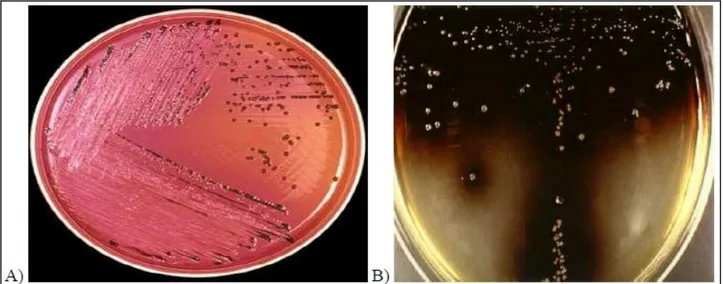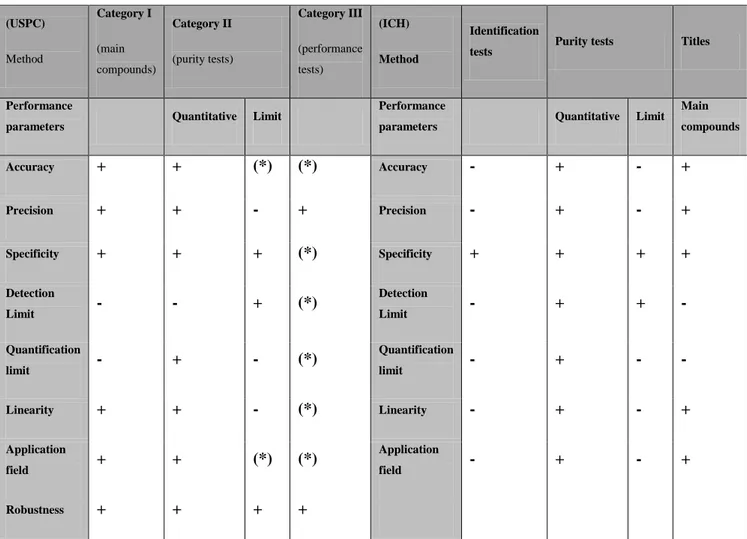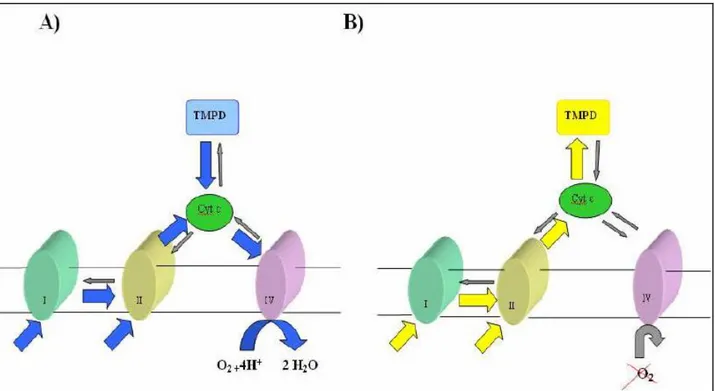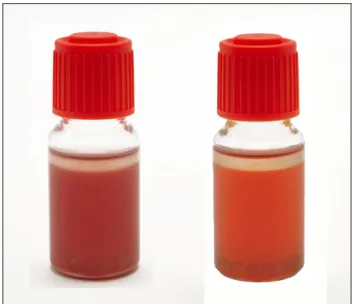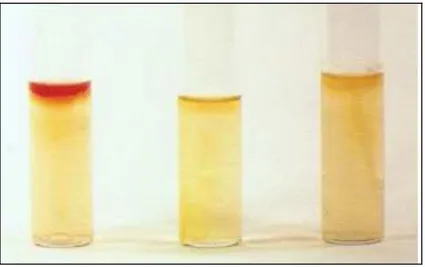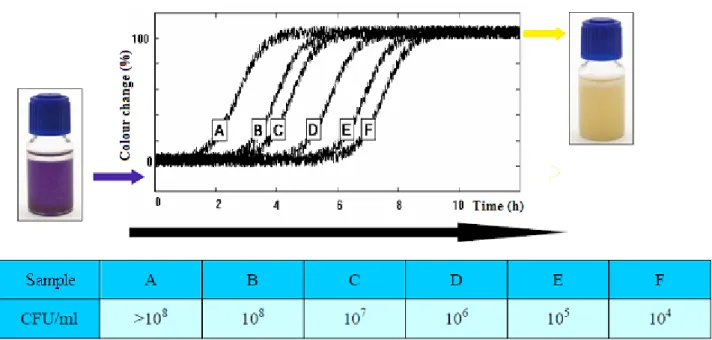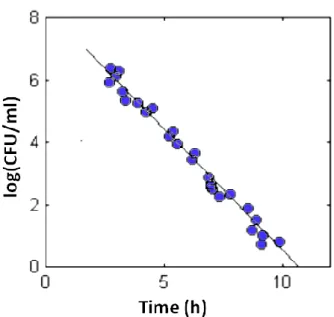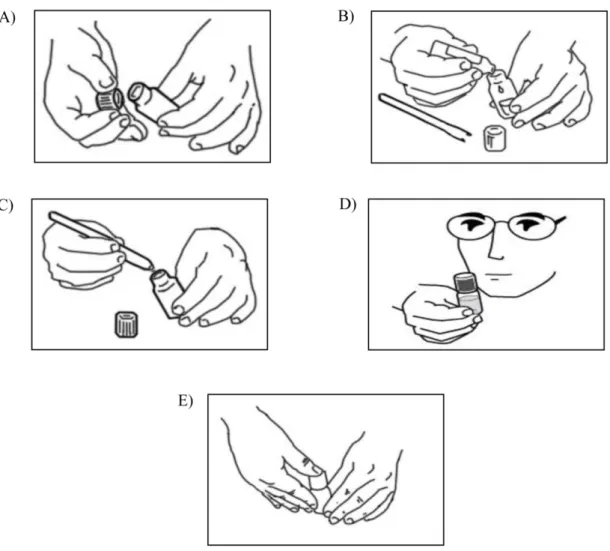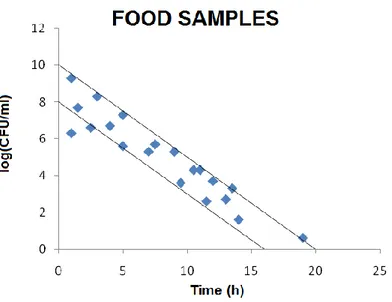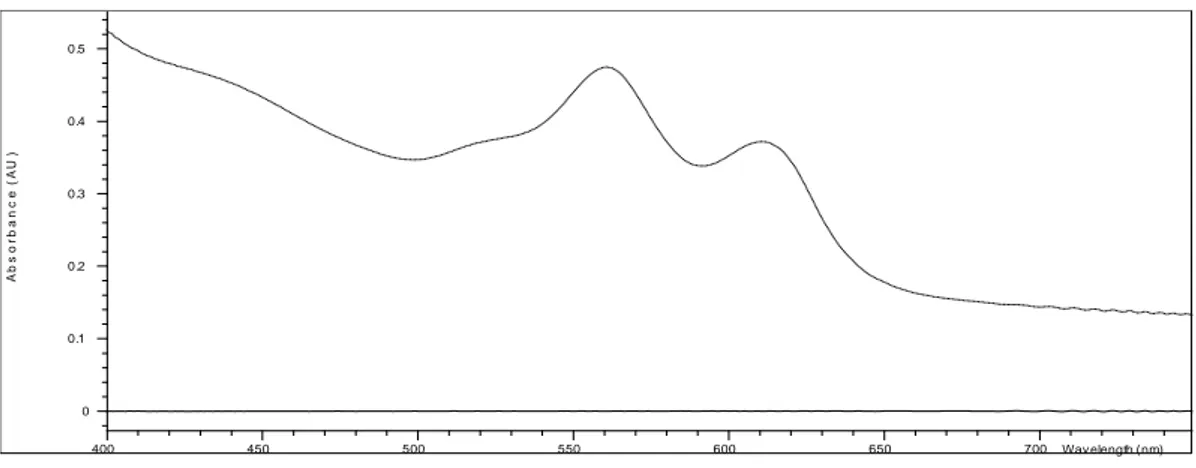1
UNIVERSITA’ DEGLI STUDI “ROMA TRE”
FACOLTA’ DI SCIENZE MATEMATICHE, FISICHE E NATURALI
Scuola Dottorale in BIOLOGIA
Sezione: SCIENZE BIOMOLECOLARI E CELLULARI
XXV Ciclo
“VALIDATION AND STABILITY STUDIES ON THE MBS
METHOD FOR MICROBIOLOGICAL CONTROL
OF FOOD SAMPLES”
Relatore: Dottoranda:
Prof. Giovanni Antonini Giorgia Bottini
2
INDEX
CHAPTER I: INTRODUCTION ... 5
1.1 Food borne diseases ... 5
1.1.1 Major food borne pathogens ... 5
1.2 Main indicators of food microbial contamination ... 7
1.2.1 Hygienic indicators: Total Viable Count (TVC) ... 7
1.2.2 Indicators of faecal contamination: coliforms and Escherichia coli ... 8
1.2.3 Other relevant pathogenic microorganism ... 9
1.3 Food law evolution ... 10
1.3.1 Food safety and quality... 11
1.3.2 The new microbiological standards: European Directive 2073/2005 ... 12
1.3.3 The HACCP system... 19
1.4 Regulation EN ISO/IEC 17025:2005 ... 20
1.4.1 Generality and main principles of the regulation ... 20
1.4.2 Technical requirements general description ... 21
1.4.3 Test methods validation ... 21
1.5 Regulation EN ISO 16140:2003 ... 23
1.5.1 Main principles of the regulation and validation procedures ... 23
1.6 Micro Biological Survey Method ... 24
1.6.1 Principles and biochemistry of the method ... 24
1.6.2 Performance ... 29
CHAPTER II: AIM OF THE WORK ... 34
CHAPTER III: MBS REAGENTS STABILITY ... 36
3.1 Introduction ... 36
3
3.1.2 Stability studies... 36
3.1.3 Accelerated aging ... 37
3.1.4 The importance of chemical composition and storage conditions ... 39
3.2 Materials and methods ... 40
3.2.1 MBS reagents stability tests ... 40
3.2.2 Methods of analysis of reagent stability ... 41
3.2.2.1 Chemical test and physical stability ... 42
3.2.2.2 Microbiological stability test ... 44
3.3 Results ... 45
3.3.1 Stability tests... 45
3.3.2 Reagents modifications... 46
3.3.2.1 Modification of TVC reagent ... 46
3.3.2.2 Modification of COLI reagent ... 49
3.3.3 Packaging... 52
3.3.3.1 The use of Vaseline in MBS reagents ... 52
3.3.3.2 Humidity protective packaging ... 52
3.3.4 Accelerated aging tests summarizing tables ... 55
CHAPTER IV: MULTI READER SET-UP ... 57
4.1 Introduction ... 57
4.1.1 Device description ... 57
4.1.2 Software design ... 62
4.2 Operating principle ... 63
4.2.1 Algorithm... 65
CHAPTER V: VALIDATION OF THE MBS METHOD FOR TOTAL VIABLE COUNT AND E. COLI IN FOOD SAMPLES ... 68
5.1 Introduction ... 68
5.1.1 The importance of validation ... 68
5.1.2 Reference methods ... 69
4
5.2.1 Statistical analysis on artificially contaminated water samples ... 70
5.2.1.1 Bacterial strains ... 70
5.2.1.3 Colorimetric MBS method procedure ... 71
5.2.1.4 Reference method ISO 9998 ... 72
5.2.1.5 Statistical analysis ... 74
5.2.2 Primary validation ... 75
5.2.2.1 Bacterial strains ... 75
5.2.2.2 Preparation of artificially contaminated samples ... 75
5.2.2.3 Preparation of different levels of contamination of naturally contaminated food samples 76 5.2.2.4 Analysis of 1 gram of non-homogenized food ... 79
5.2.2.5 Colorimetric MBS method procedure ... 81
5.2.2.6 Reference method ... 81
5.2.2.7 Data analysis ... 82
5.3 Results ... 82
5.3.1 Statistical analysis on artificially contaminated water samples ... 82
5.3.2 Primary validation ... 84
CHAPTER VI: CONCLUSIONS AND FUTURE PROSPECTIVE ... 105
BIBLIOGRAPHY ... 108
5
1
CHAPTER I
Introduction
1.1 Food borne diseases
1.1.1 Major food borne pathogens
Food and water represent important vehicles in the spread of food borne infectious diseases that constitute a major public health problem not only in underdeveloped countries but also in those with high socio-economic development (in the U.S., for example, there are an average of 15 million cases of food borne illness each year, of which about one third are due to bacterial etiologic agents). Food borne diseases are disease states that occur as a result of consumption of food or drinks that have been contaminated by a pathogenic microorganism or by a bacterial toxin (Barbuti et al., 2002). They are distinguishable in three categories depending on the pathogenicity:
Food borne infections: they are caused by the ingestion of live pathogens, with subsequent invasion and multiplication within the gastrointestinal tract or in other tissues; a classic example is the food borne infection caused by Listeria monocytogenes.
Food borne intoxications: they are caused by the ingestion of bacterial toxins. They are pathological events resulting from the consumption of food containing toxins produced by microorganisms that have multiplied in food before its consumption. Thus for intoxication to manifest itself microorganisms must not be necessarily present; instead the presence of the toxin is necessary and sufficient. Examples of food borne intoxications are the diseases caused by the toxins of Clostridium botulinum and
Staphylococcus aureus (Murray et al., 2003).
Food toxicoinfections: they are caused by the ingestion of food containing both bacteria and their toxins. In this case, toxicity is doubled and is given both by the toxins and by living microorganisms within the food. A widespread food borne toxicoinfection that can be used as an example is the one caused by bacteria of the genus Salmonella (Cevenini, 2000).
The pathogenic patterns of infections and intoxications, while substantially different, are generally included in the name of "food toxicoinfections". This term identifies a group of
6 syndromes that are different from food borne infections that are characterized by the epidemiological specificity of being transmitted only after that a bacterial multiplication has occurred in food. Poisonous chemical compounds, such as pesticides used in agriculture can also cause food contamination: to avoid this problem use and distribution of these substances are strictly regulated, with an approach based on prevention more than research of the substances themselves. Food borne toxicoinfections usually affect the gastrointestinal tract, appearing suddenly after a short period of incubation (from a few hours to 1-2 days) and developing into an epidemic among those who consumed the contaminated food.
Factors affecting the occurrence of toxicoinfection, disturbing or favouring bacterial multiplication, are: temperature, pH, osmotic pressure, saline concentration, amount of oxygen and food characteristics. In order to induce toxicoinfections the presence of bacteria in food is not sufficient, it is in fact necessary for the bacteria to reach a certain concentration, the so-called minimum infectious dose, high enough to cause infection; this is typically in the order of ~ 104 cells / gram, even though this value can be either higher, as for V. cholerae, or lower and even down to a single unit, as for some species of Shigella (Barbuti et al., 2002).
One of the factors which make food borne illnesses so important is the tendency, in the last years, to a significant increase of their incidence. The reasons for the increase of these diseases are different:
1) The demographic changes occurring in industrialized countries that have led to an increase of the amount of population susceptible to such infections.
2) The increased consumption of food that can be easily contaminated (such as vegetables and fresh fruit) or not properly cleaned, and the increased tendency to eat in restaurants (Jones & Angulo, 2006), are also secondary causes of the increase of these diseases.
3) The expansion of food industry itself plays an important role, since the wide distribution of products derived from industrial processes can represent an important risk of widespread epidemics (Angelillo et al., 2001).
Currently, they exist more than 250 types of food borne toxicoinfections. The most common, even in developed countries, are those caused by bacteria belonging to Salmonella spp. and
Escherichia coli (E.coli); regarding diseases that are caused by the production of toxins, the most
hazardous pathogens are Staphylococcus aureus, Clostridium botulinum and Clostridium
perfringens.
Furthermore emerging pathogens such as E.coli O157: H7, Yersinia enterocolitica and
7 mentioned, are second only to Norwalk-like viruses as agents of food borne illnesses (Tauxe, 2002).
1.2 Main indicators of food microbial contamination
1.2.1 Hygienic indicators: Total Viable Count (TVC)
The Total Viable Count TVC is a parameter that allows to obtain a general picture of the hygienic state of the sample, whether it is a food sample or a surface, and to establish if the procedures adopted during production (in case of a food sample) have been able to control successfully contamination and bacterial growth.
Given that the incubation temperature is 30°C, the TVC parameter allows to determine the presence of mesophilic microorganisms ( able to grow in warm-blooded animals as human beings) in a food sample; however it does not provide any information on the type of microorganisms present. This information is particularly important in relation to the shelf-life of the product; in good preservation conditions in fact it is clear that the shelf life of a product is in inverse proportion to the level of bacteria initially present.
Figure 1: A) Total Viable Count on PCA; B) Growth on MacConkey agar of lactose negative (transparent colonies)
and lactose positive (coliforms, pink/red colonies) Enterobacteriaceae; C) Growth of E. coli on selective TBX agar; D)Growth of coliforms (metallic green) and lactose negative Enterobacteriacea on EMB agar
8 TVC is frequently higher than zero in food products and on surfaces with acceptable limits that vary and depend from type of product (for example the upper limit acceptable for dairy products is quite high, as for raw meat); higher is the amount of bacteria present higher will be the possibility that among these they will be pathogens potentially harmful for humans (Tiecco, 1997).
1.2.2 Indicators of faecal contamination: coliforms and Escherichia coli
At the end of XIX century Schardinger (1892) introduced the use of gram negative bacteria taxonomically related to Salmonella typhi as possible markers to detect water safety; a few years later, in 1904, Eiijkman set up a test for the isolation of E.coli by increasing the temperature of incubation at 46°C.
The survey techniques available at the beginning of the century for the detection of this bacterial species weren’t able to grant a routine monitoring and a rapid verification of fecal contamination; for this reason a larger group of similar microorganism (that included E.coli) were subject of research as surrogate indicators.
This group was named “of coliforms” by Blachstein in 1893 (Tallon et al., 2005; Kornacki & Johnson, 2001), and it has been subjected to many taxonomical revisions especially with the advent of extremely precise molecular methods of classification: Bacterium coli is now known as
Escherichia coli, Bacterium Aerogenes as Enterobacteraerogenes and the different species of
minor importance have all been reclassified correctly.
More than a real taxonomic entity, the coliform group is substantially an operating definition useful “on field”, that includes all the lactose-fermenting Enterobacteria. These are present in the intestinal tract of warm blooded vertebrates and have an average concentration of 109 CFU/g in feces; fecal coliforms instead reach a concentration of 107 CFU/g. To this group belong Enterobacteria that inhabit exclusively the gastro-intestinal tract but also of environmental origin. Apart from E.coli, in most cases microorganism defined as coliforms have essentially a saprophyte life cycle; therefore their presence in foodstuff is not necessarily index of fecal contamination or of the presence of pathogens (Jay et al., 2005).
The definition of “fecal coliforms” was therefore revised due to their not strict fecal origin: it results in the more actual and precise form of address of thermo tolerant coliforms. Depending on some physiological and biochemical characteristics three groups of coliforms can be distinguished:
9
Total coliforms: gram negative rods, non-sporing, facultative anaerobic, catalase +, oxidase -, belonging to the family of Enterobacteriaceae; they are able to grow in the presence biliary salts and ferment lactose producing acid and gas in 24-48 h at 30-37°C.
Fecal coliforms or thermo tolerant: they have the same properties of the other coliforms but that grow also at 44,5°C.
Escherichia coli is a species taxonomically defined of Enterobacteriaceae with all the
characteristics to be an excellent indicator. E.coli belongs to the group of thermo tolerant coliforms, it is non-sporing, facultative anaerobic, lactose-fermenting; it is normally present as non-pathogenic commensal of the intestinal tract of humans and other warm-blooded animals, that is colonized a few hours after birth (Tallon et al., 2005; Alonso et al., 1999; Leclerc et al., 2001). The 93% of E.coli isolates are lactose-fermenting, and only some diarrheagenic isolates are lactose negative; the test for the production of indole from tryptophan is positive for the 99% of isolates; it is very precise and utilized also as confirmation test through the Kovacs reagent. In anaerobiosis all ferment glucose producing acid and gas, they are catalase + (differing from the other thermo tolerant coliforms) and the 97% of isolates have β-glucuronidase activity; this property is highly selective and it is used in the more recent laws for the search of E.coli in food microbiology. A series of biochemical tests, called IMVC, is based on the multiple assay for the production of indole from tryptophan (I), the reaction of methyl red (M), the Voges-Proskauer test (V, production of acetoin) and the ability to grow on Citrate agar (C): the biochemical profile of E.coli I(+); M(+); V(-); C(-).
1.2.3 Other relevant pathogenic microorganism
Unlike E.coli, Staphylococcus aureus cannot be considered as an index of contamination but rather as an indicator of hygiene of the process and, at the same time, as a potential pathogen. The microorganisms of the genus Staphylococcus belong to the family of Micrococcaceae, Gram-positive cocci, non-sporing, facultative anaerobic, catalase +, and capable of producing a variety of toxins and enzymes (among which coagulase). They can be isolated from many animal products such as meat and dairy products and come from raw material, but usually their presence is related to poor manipulation. Food is hardly ever suitable for bacteria replication, but if during the storage the conditions are established toxin production and consequent intoxication may occur. Among bacteria researched for food safety it is important to mention the group of microorganism belonging to Salmonella spp. and Listeria monocytogenes (Figure 2 A and B).
10 example, infect the ovaries of hens and contaminate the egg before the shell is formed, and subsequently develop if the egg is eaten raw); Listeria is a particularly insidious species both for the severity of clinical manifestations that is able to establish (the heterogeneous, from a clinical point of view, listeriosis) and for the extreme psicrofilia (Tiecco, 1997).
Figure 2: A) Salmonella on XLD agar; B) Listeria monocytogenes on Oxford agar
1.3 Food law evolution
Since the '90s, the food processing sector has been involved in several crises that pointed out to Government and public opinion all the issues concerning food safety.
In particular, the Bovine Spongiform Encephalopathy epidemic, the spread of avian flu and contaminations by dioxins, PCBs and mycotoxins, demonstrated the weakness of the European Community food policy, bringing to light several critical points:
The ineffectiveness of food legislation and regulations, due to an excessively fragmented structure that controls only the finished products and provides pointless details for food safety;
The disorganization and disparity between official controls, due to marked organizational differences between Union members;
The insufficient controls on animal feed that have shown to be crucial to prevent many food borne diseases;
In this context apart from the difficulty to foresee and manage public health crises it is also important to consider some cultural, social and economic transformations that concerned the food industry, leading to an increased demand for controls to assure food safety. Among these:
11
The globalization of markets of food products and raw materials: that causes an obvious difficulty in detecting and containing the risk. The trend to minimize food processing in order to obtain more fresh, nutritious and tasty products: this search for authenticity, though commendable, is an additional element of risk because it increases the risk of contamination.
The growing attention of consumers towards food safety, that led the European Commission to reach for the highest standards possible.
The legislative innovations introduced by EC Regulation 178/2002 and especially by the so-called "Hygiene package" in 2006 (that represents its natural implementation), consider as possible all these points: through a process of awareness and acquired responsibility, all food chain operators, from raw materials producers to consumers, can be involved and have an active role in the control of food safety. The principles of this new legislation result in a radical change in approaching food safety, which translates into a greater awareness of personal rather than company responsibilities (Roggi & Turconi, 2003).
1.3.1 Food safety and quality
Until the mid-'90s, food control in Italy and in the other countries of Western Europe was focused on the finished product. The controls included a series of inspections carried out by the competent authority to verify compliance with good maintenance and hygiene practices (GMP or Good Manufacturing Practices and GHP or Good Hygiene Practices), and random sampling of finished products. The outcome of food borne diseases dramatically revealed the limit of sampling plans especially caused by the uneven distribution of pathogen microorganisms in food. This approach can in fact be totally ineffective when there is a serious risk of contamination at low bacterial concentrations and in case of diseases with low or quite variable prevalence (as, for example, listeriosis).
Since the mid-90s controls are no longer concentrated on the finished product, but they are rather distributed throughout food processing, making food chain operators ever more responsible for food safety. The introduction in food companies of the concept of quality as an added value from the '80s has greatly accelerated this process, which had been already in operation by law.
In this context, the assurance of food quality and safety becomes an essential determinant of the quality system: the evolving legislation has led companies to consider quality as a determining criteria indispensable in a context of choice that has now evolved into a requirement imposed by law (Civille, 1991).
12 1.3.2 The new microbiological standards: European Directive 2073/2005
EC Regulation 2073/2005, which is complementary to Regulation 852/2004 and in force since 1 January 2006, represents an element of innovation in microbiological food control and, in the coming years it will become the legislative reference model for microbiological food safety policy.
The fundamental principles are the following:
Food must not contain microorganisms, their toxins or metabolites in quantities sufficient to represent an unacceptable risk for human health.
Microbiological criteria indicate the acceptability of a product and its processing, handling and distribution.
The application of microbiological criteria is a part of HACCP procedures and must be implemented with the other hygienic control measures. Microbiological criteria are defined in EC Regulation 2073/2005 Article 2 as "criteria defining the acceptability of a product, a batch of foodstuffs or of a process, based on the absence, presence or the number of microorganisms and / or based on the amount of their toxins / metabolites, per unit mass, volume, area or lot" (Villani, 2007; Galli Volonterio, 2005). The implementing Regulation EC 2073/2005 lays down microbiological criteria for the major microorganisms able to cause food borne diseases, through the analysis of the microbiological risk. These criteria are not absolute and they can be modified, if necessary, to take account of the evolution of food safety and food microbiology: advances in science, technology and methodology, changes in the prevalence and levels of contamination, the percentage of vulnerable consumers and any unexpected results emerging from the evaluation of risks. Setting safety criteria for food pathogens has undoubtedly the advantage of providing simple standards for the acceptability of food products: however, it is not possible to assess how public health could be positively influenced by the protection provided by specific food safety criteria. Microbiological tests alone can, in fact, generate false negatives due to the limitation of statistical sampling plans, especially in cases where the danger represents an unacceptable risk even at low concentrations and / or low and variable prevalence (Villani, 2007). Food safety is in fact a result of several factors: microbiological criteria should therefore be respected along with the other aspects of EU food policy, like HACCP and official controls to verify the compliance of operators.
The elements to research as described in the Regulation are:
Listeria monocytogenes
13
Staphylococcal enterotoxins
Enterobactersakazakii
Escherichia coli
Histamine levels
The document describes in detail how to relate these parameters to the different food matrices where they are presumably present (and therefore they have to be researched), and the principles of the sampling plan that have to be activated, referring to ISO standards (International Organization for Standardization) and guidelines of Codex Alimentarius (set of rules and standards developed by the Codex Alimentarius Commission, commission established in 1963 by FAO and WHO). According to these Regulations, food chain operators must ensure the respect of hygienic criteria in food processing and food safety throughout the shelf-life of the products (Art. 3) (Jay et al., 2005). In this regard, two distinct categories of microbiological criteria are defined:
Food safety criteria defines the acceptability of a food product / batch, and it should be applied to products on sale;
Hygienic criteria of the process defines the acceptability of the process: it cannot be applied to products on sale but to their intermediate (meat and meat products, milk and dairy products, egg products, fishery products, vegetables, fruits and products thereof); it indicates the specific levels of contamination that must be respected and above which corrective measures are needed (Ray, 2004).
As already mentioned, EC Regulation 2073/2005 should be considered an “open” standard, a first list of microbiological limits, scientifically determined, that should be updated depending on epidemiological evidence leading to new criteria that should be followed with the same strictness. Modifications have already been performed, for example, through L.ve Decree n. 193 and EC Regulation 1441/2007 that modified, in a more or less relevant way, the analysis procedures and the microbiological limits of acceptability of some food products. The following table (Table 1) lists the basic microbiological limits provided in Regulation No 2073/2005, including the updated 1441/2007.
18
19 1.3.3 The HACCP system
To ensure food safety, a method of self-control was introduced years ago, which analyzes the entire food chain identifying the risks associated with each step and possible solutions. This method is called HACCP: Hazard Analysis and Critical Control Point.
HACCP was introduced in Europe by Directive 93/43 and in Italy with Legislative Decree 155 of May 26, 1997, that required the application of HACCP for all the food chain operators at any level of the food chain. This decree was repealed and replaced by CE n.852, 853 and 854 of 2004 (the aforementioned "hygiene package" from 1 January 2006), that define the general hygienic rules of hygiene for all food products and for industries and the policy of official controls. Furthermore EC Regulation n.2073 of 2005, defines the microbiological criteria for foodstuffs and the various standards for sampling. These standards provide control along the entire chain of production and distribution of food, in order to ensure food safety and nutritional quality, in order to protect consumers and the market. Food chain operators must obviously also take into account the "Handbook of Self-control and good hygiene practices for food collective ".
The Manual’s aim is to define and make accessible to operators and official organs of control, the procedures underlying the identification and control of critical points throughout the production line, and also the roles and responsibilities of personnel involved in the self-control system. It explains step by step all the operations required to preserve hygiene of premises, equipment, staff and in food preparation, as well as the way to manage unsuitable products or waste, and explains how to organize all the documentation. In addition this manual establishes the frequency of quality checks of the self-control system that help document the effectiveness of prescriptions, and a program of information and training, addressed to the staff, to raise their awareness on the issues related to the hygienic quality of food (Mortimore, 2001; Untermann, 1999). Thus, the term HACCP identifies a system designed for food safety and it is based especially on prevention, allowing operators to intervene before hygienic safety is threatened. This method is defined pro-active and ensures the production of healthy food ready for human consumption (Cullor, 1997).
In essence, companies that adopt such a system must accomplish two important actions: identify within their food production process (industrial, commercial, catering, etc...), the specific hazards that may impair in any way food wholesomeness during all its "stages" (that is until its consumption) and develop more appropriate measures of prevention and control to ensure food safety. HACCP has been built around seven basic principles:
20 2) determination of critical control points (CCP);
3) determination of critical limits for CCPs;
4) establishment of a supervising system of the CCP; 5) determination and establishment of corrective actions; 6) establishment of testing procedures;
7) determination of a system that manages all the documentation.
It is therefore important to consider the risks and dangers that foodstuff could encounter at various stages from acceptance to distribution and consumption, and evaluate analytically at each stage of the process, the critical points of Control (CCP), the critical limits and, in case of noncompliance, the corrective actions to adopt. The importance of monitoring critical control points should be therefore emphasized: this is represented by a programmed series of observations or measurements to verify that a particular CCP is in control. The monitoring system will ascertain that, at defined times, the chosen parameter respects the critical limits established. The monitoring control system should provide information in a reasonable time so that, in case a critical point is no longer under control, corrective measures can be undertaken. In addition, controls must be planned in order to be frequent enough to ensure, in any time, the precise control of the selected parameter. Planning an adequate monitoring system allows therefore to identify whenever a parameter is far from the critical acceptability limits and to intervene rapidly, identifying products obtained in the period where critical limits were exceeded, and destining them to recovery or destruction after submitting them to appropriate controls (Buchanan, 1995).
1.4 Regulation EN ISO/IEC 17025:2005
1.4.1 Generality and main principles of the regulation
The UNI EN ISO/IEC 17025 is a standard that includes technical and managerial requirements and it is widely utilized to achieve the accreditation of testing and calibration by all laboratories. The term “accreditation” is used instead of the well-known “certification” as by the National System for Quality, testing and calibration laboratories are classified as “ specialized operators in evaluation of conformity”, qualified to perform tests and calibrations granting accuracy and adequacy that are performed using “calibrated” instruments.
Unlike ISO 9001, that a company achieves implementing a quality control system to provide goods or services that meet consumers requirements, accreditation is achieved for a test or
21 calibration that is able to pass an inspection test performed by the competent authority, that attests compliance to the law. For this reason a laboratory that has a Sinal or a Sit accreditation has not acquired an automatic recognition for all its tests and calibrations, but only for those that after a specific request have passed successfully the inspection.
1.4.2 Technical requirements general description
The requirements that a laboratory must attend are technical and administrative. The first are very similar to those indicated in UNI EN ISO 9001, but do not concern the obligation to create a section dedicated to the design and develop of the new method and the related processes. The general technical requirements are the following:
1) Personnel of the laboratory :certification of skills and appropriate qualifications, training, regular contract;
2) Laboratory environment: suitability of laboratory equipment and conditions, with attention to biological sterility, dust, electromagnetic interference, radiations, humidity, electrical supply, temperature, vibrations and noise;
3) Reference methods: using the most up to date, which are scientifically and internationally recognized;
4) Validation methods: exhaustive documentation , including references and data for each test performed.
1.4.3 Test methods validation
Section 5.4.5.1 of UNI CEI EN ISO/IEC 17025 defines validation as "the confirmation by examination and adduction of objective evidence, that the specific requirements for the intended use are fulfilled ", practically it is the demonstration that the efficiency of the testing method is comparable with that required by the reference method for the same type of test. Greater is the degree of comparison between the two methods, greater is the effectiveness of the procedure. A testing method must be validated in the following cases:
the method is designed and / or developed by the laboratory;
the method is standardized, but it is used outside of the purpose and / or field of application originally intended;
22 When the method presents broad-spectrum applications, the validation can be performed in collaboration with other laboratories; instead, when the method cannot be spread or is not widely used it can be performed by one laboratory. In this case, the achievement of a validation can be performed using various techniques that include the use of certificated material, the comparison with results obtained with other methods and so on. The are several parameters that must be evaluated during the validation of a method ; assistance for the identification of the appropriate is provided by general outlines, as those provided by the USPC (United States Pharmacopeial Convention) and the ICH (International Conference on Harmonisation of Technical Requirements for Registration of Pharmaceuticals for Human Use), summarily indicated in Table 2. (USPC) Method Category I (main compounds) Category II (purity tests) Category III (performance tests) (ICH) Method Identification
tests Purity tests Titles
Performance
parameters Quantitative Limit
Performance
parameters Quantitative Limit Main compounds Accuracy + + (*) (*) Accuracy - + - + Precision + + - + Precision - + - + Specificity + + + (*) Specificity + + + + Detection Limit - - + (*) Detection Limit - + + - Quantification limit - + - (*) Quantification limit - + - - Linearity + + - (*) Linearity - + - + Application field + + (*) (*) Application field - + - + Robustness + + + +
Table 2: General criteria of validation provided by USPC e ICH, not specifically intended for food microbiological
analysis
According to the criteria established by USPC analytical methods are grouped into three categories: the first one includes all the test methods that are used to quantify a specific component of a material or of a compound; the second groups the methods used for the
23 determination of secondary components, such as degradation compounds or impurities; the third is representative of all testing methods that analyse specific features of materials or products (also known as "behaviour tests"). The difference between ICH and USPC criteria is that behaviour tests are eliminated and replaced with qualitative test, that aim to detect the presence of a given compound in a material or a product trough specific recognition reactions.
The validation of a method requires a careful planning. This must define the resources that have to be employed, the requirements that have to be accomplished and (if already existent) the criteria used to choose the method itself. The selected method should then be described as clearly as possible, collecting and quoting all the existing information about it; after this it is important to identify the performance parameters to control and, for each one of them, the criteria used to determine the critical limits according to the results obtained for each parameter.
The validation of a method is confirmed by the comparison of all the results obtained for each parameter with the correspondent critical limit. A final evaluation including the reference method considered must then be drawn. These outlines are to be considered indicative, however, as the guidelines of ISO 17025; the choice of the performance parameters depends strictly from the type of test and the class to which it belongs. The parameters needed for the validation of a method for which there is already a specific legislation are in fact different from those needed for a "not regulated" method, as one that has been fully developed by one laboratory. In areas where the advent of alternative methods is frequent specific rules are generally available: these are not limited to a general approach but provide a precise technical protocol to follow during the validation test. Even in the field of food microbiological quality, there is a specifically dedicated legislation: UNI EN ISO 16140 in 2003. This establishes, in a much more specific way compared to the guidelines provided by ISO 17025, all the requirements and procedures of validation for new analytical methods in food microbiology.
1.5 Regulation EN ISO 16140:2003
1.5.1 Main principles of the regulation and validation procedures
The UNI EN ISO 16140 establishes the basic criteria and the technical protocol needed for the validation of alternative methods for microbiological analysis of food, feed and environmental samples. An alternative method is intended as a protocol of analysis that estimates the presence/absence or the quantity of a given analyte in certain products, as well as the related internationally recognized and accepted reference method. The validation consists in the
24 demonstration that there is an acceptable comparability between the results obtained with both methods ensured by a statistical analysis of data obtained on a given number of samples. The analyte, or better the component detected by the analytical method, is almost always represented by a microorganism or by its metabolites or toxins. Results depend on the analysis and can be of two different types:
1) Qualitative: the results obtained are expressed as presence or absence of the analyte under consideration; these analysis concern important pathogens that have to be necessarily absent, as
Listeria monocytogenes or Salmonella spp.
2) Quantitative: the results obtained indicate the amount of analyte directly (as the enumeration of colonies) or indirectly (as absorbance) measurable, expressed in relation to the amount of sample in weight or volume; these analysis concern parameters as Total Viable Count or the detection of coliforms.
For these tests the food safety policy doesn’t require the total absence of the analytes but indicates critical limits of acceptability that can range in relation to the product.
Validation requires two basic steps: the first one is “internal”, performed within the laboratory that planned the research, the second one is “external”, so called inter-laboratory where the results obtained by different laboratories for the same samples are compared.
Both steps, can easily be performed at the same time because the alternative method is used along with the reference one; in this way the two methods can be compared, as well as the results obtained by different laboratories, in order to establish the efficacy of the analytical system that has to be validated and to obtain an evaluation from technicians and operators apart from those who participated to develop the method.
1.6 Micro Biological Survey Method
The MBS method, used and validated in this thesis, is a rapid colorimetric assay that allows to selectively detect and quantify various microorganisms.
1.6.1 Principles and biochemistry of the method
The analytical base is the measurement of the catalytic activity of enzymes of primary metabolism of bacteria that allows the establishment of a direct correlation between enzymatic activity detected and microbial load in the sample. Detection of enzymatic activity is made possible thanks to the presence of a redox indicator called TMPD (N, N, N ',
N'tetrametil-p-25 phenylenediamine hydrochloride), capable to change colour as a consequence of the modification of redox potential of the culture medium. TMPD is yellow in its reduced form, and it becomes blue in its oxidized form; its potential, of about 250 mV (Prince et al., 1981), is very close to the one of cytochromes belonging to the mitochondrial electron transport chain, which goes from 100 to 300 mV (Moran et al, 1996). For this reason, this indicator can be easily reduced by cytochromes and at the same time can be directly oxidized by the oxygen present, which has a potential of about 820 mV (Moran et al, 1996). A distinctive characteristic of TMPD is to be an anphipathic molecule, capable to cross the cytoplasmatic and mitochondrial membranes and rapidly reduce cytochrome c (Sarti et al., 1992). The reaction vials include in addition to selective medium for the detection of microorganisms, an appropriate amount of vaseline (1.5 ml) to prevent the passage of atmospheric oxygen in the solution, acting as a "cap". Initially, bacterial growth in is in lag phase and, consequently, the oxygen present in the vial oxidizes the indicator that becomes blue. When bacterial growth passes to the log phase, being in the presence of oxygen, all electrons are transported toward the IV complex of the respiratory chain favouring reduction of oxygen and, consequently, leaving TMPD in its oxidized blue form (Figure 3A). Once bacteria have used all the oxygen present in the vial, respiratory chain will arrive at a point of saturation and electrons will be transferred on TMPD, that will be reduced turning yellow (Figure 3B).
26 The reaction in the medium used for Total Viable Count (Figure 4) goes exactly as described and, given the type of examination, there is no need of selective agents.
Figure 4: Change of colour of the MBS vials for TVC: the colour change is due to reduction of TMPD in its yellow
reduced form by oxidoreductase enzymes of bacterial primary metabolism
In E.coli vials, instead, colour changes from red to yellow, thanks to the presence of an indicator called Phenol Red that detects oxygen-independent metabolic processes, as lactose fermentation; in this case there is an acidification of the medium that can be observed colorimetrically by the colour change of Phenol from red to yellow (Figure 5).
Figure 5: Change of colour of the MBS vials for E.coli: the colour change is due to reduction of TMPD in its
yellow reduced form by oxidoreductase enzymes of bacterial primary metabolism
In addition to Phenol Red and TMPD, the reagent for E.coli detection contains Piperacillin-selective agents (inhibiting the growth of several faecal coliform) and Cycloheximide (against yeasts growth), that along with the incubation at 44° C, ensure the specificity of the medium. It is therefore possible to observe the colour change of Phenol Red, once TMPD is completely reduced due to the consumption of oxygen, only in the presence of Enterobacteriaceae able to
27 ferment lactose at 44 ° C. At this temperature, and in the presence of these selective compounds, the growth of E.coli is predominant compared to that of other thermo-tolerant coliforms (Figure 6).
Figure 6: Change of colour of MBS vials for the detection of E. coli. A) Initial phase; B) Change of colour due to
TMPD; C) Change of colour due to PR
To note is how the analysis of samples containing enteric bacteria other than E. coli does not show a colour change to yellow, in fact after 24-48 hours the reagent is red / orange, demonstrating the specificity of MBS method to E. coli. The orange colour is due to TMPD and it is typical of all Enterobacteriaceae, while the yellow colour is due to Phenol Red and to the ability to ferment the lactose with high efficiency (Figure 7).
Figure 7: Change of colour of MBS vials for the detection of E. coli with lactose negative Enterobacteria without
28 The presence of E.coli in the samples is confirmed through the Indole test with Kovacs reagent. Adding a few drops of this compound in the vials, after colour change is completed, a red ring appears on the surface of the medium thanks to the reaction between indole (Gas produced from tryptophan, through a specific enzyme of E.coli and a few other bacteria) and p-dimethylaminobenzaldehyde, of Kovacs reagent (Figure 8). Some strains of E.coli (~ 5%), especially among those that can be found in water, however, do not produce indole; instead, other coliforms (~ 3.4%) as certain strains of Klebsiella and Citrobacter freundii oxytocae, can be indole producers (Anderson & Baird-Parker, 1975).
Figure 8: Samples tested with Kovacs reagent. Only the first one results positive with an evident red ring caused by
the reaction of reagent compounds and indole produced by microorganisms in the vial (Image modified from MontgomeryCountyCommunity College, Healt Sciences Database)
This apparent limit of the method, however, does not undermine its efficiency, since the reference method ISO 16649 itself doesn’t take account of the whole E.coli group. There isn’t indeed an absolute correspondence between E.coli and β-glucuronidase (Chang et al., 1989; Frampton & Restaino, 1993; Hansen & Yourassowsky, 1984; Kilian & Bulow, 1976), in particular for E. coli isolated in food, that result β-glucuronidase-positive only for the 85% (Maheux et al., 2008).
It’s also known, as already mentioned in the specifics of TBX medium, that many Coliforms and Enterobacteria other than E. coli, such as some strains of Salmonella and Shigella, are producers of β-glucuronidase ( Damare, 1985; Ushiyama & Iwasaki, 2010); furthermore some of the most pathogenic strains, such as verocitotoxin producers (eg E. coli O157: H7), result β-glucuronidase
29 negative (Scotland, 1992) but indole producers, and therefore detectable by the MBS method and not by the reference method ISO 16649.
1.6.2 Performance
The principles of MBS method can be described using for example an experiment conducted on water samples, which are analyzed in the same way of any other type of sample (after homogenization in saline solution or in buffered peptone water for solid food matrixes).
Six sterile reaction vials containing the MBS TVC reagent were inoculated with artificially contaminated water samples. After a certain time the vial changed colour going from blue to yellow (Figure 9); the correlation between bacterial concentration in the samples and the time taken to change colour is clearly linear (Figure 10).
The sensitivity of the method to different microbial genera, as described later, is obtained using specific reagents that contain inhibitory substances against microorganisms other than those researched; these selective agents are usually already used in traditional cultivation mediums. In order to obtain what described, and meet nutritional requirements of different microorganisms, MBS reagents contain different classes of compounds:
Nutrients: mainly sugars lipids, and proteins;
Selective agents: organic substances (eg surfactants), antibiotics (egpolymyxin) and salts not ordinarily present (egCsCl) or common but in concentrations different from the physiological one (EgNaCl);
Reducing agents: organic substances capable to release electrons to the respiratory chain, and that are not easily oxidized by the oxygen dissolved in solution;
Indicators: organic substances capable of changing colour in result to variations of the chemical and physical state of the medium. In particular the two indicators utilized are: TMPD (N, N, N ', N', tetramethyl benzene-1 ,4-diamine hydrochloride), a redox indicator, and Phenol Red (PR), a pH indicator; the first allows detection oxygen consumption of microorganisms while the second detects acidification of the soil, resulting from fermentation;
Vaseline: organic substance used to avoid an external input of oxygen into the reaction vial; as highly hydrophobic compared to reagent, it sets at the interface with the air excluding the oxygen input .
30
Figure 9: Change of colour of MBS vials in relation to time. Letters A,B,C,D,E,F indicate different samples which
concentrations are reported in the table
The different components of the reagents used in the Micro Biological Survey method (composition indicated in the tables below) are micronized together in a mortar and then distributed in defined amounts, in the single vial.
Before closure, 1.5 ml of vaseline is added. After preparation, the vials are sterilized with γ rays (5kGy) in a specialized company and are then ready for use.
The gamma rays are produced by the decay of radioisotopes, particularly of 137 Cs (caesium) and 60Co (Cobalt). The latter is the main source of radiation used in heating systems for industries. The 60Co is more used then the 137Cs because it does not produce long-term radioactive waste (half-life 5.3 years), and therefore, has a lower environmental impact. It is obtained by neutron bombardment of 59Co, a non-radioactive isotope. Thanks to the high penetrating power, gamma rays can be used to treat voluminous material without leaving a trace of radioactivity on the irradiated material.
The technological properties of gamma-ray are used in different fields: for the sterilization of material and equipment primarily for medical, pharmaceutical and cosmetic use, and for everyday objects. Gamma-ray are also used for sanitizing and conservation of food not adapt to heat treatment
31
Figure 10: Correlation plot between bacterial concentrations (expressed as log CFU/ml), and time taken for vials to
change colour (expressed in hours)
This is an extremely simple method that requires the use of disposable vials, previously sterilized by γ-rays, containing the selective reagent for each microorganism. The vials are made in PET (Polyethylene Terephthalate), provided with a screw cap for a secure closure and a safety cap that includes a tank containing a sterilizing chemical compound that must be manually injected in the vial, after testing, for a proper disposal (Figure 11).
Figure 11: Disposable reaction vial
The sample can be directly introduced in the sterile reaction vial containing a specific reagent (Figure 12A): 1 ml for liquid samples (water or a homogenate of a solid or semi-solid matrix ), approximately 1g for solid samples (or directly the tampon for surfaces). After adding 10ml of
32 sterile water (Figure 12B) the vial must then be tightly closed and shaken until all the reagent is completely dissolved (Figure 12C). The final colour required to start analysis (specific for each type of reagent) is achieved in 5-10 minutes. Vials must then be placed in a thermostatic device, which allows to maintain a given temperature of incubation depending on the type of microorganisms searched (30°, 37° or 44°C). Results are obtained monitoring colour variation of the vials at different times, referring to the colour scale provided with the test kit (Figure 12D). After the analysis the safety cap is pushed down; this opens the tank that releases the sterilizing compound into the vials (Figure 12E); in a few minutes all microorganism are eliminated and vials can be disposed as non-pathogenic waste.
Figure 12: Directions for use of the disposable reaction vial in six steps: introduction of 1 ml or 1 g of sample (A),
addition of 10 ml of sterile water (B), closure and shaking of the vial (C), incubation at the specific temperature of analysis and control of re results (D) sterilization and disposal of the vial (E)
To complete the analysis it is necessary to relate the time taken by the vial to change colour to the bacterial concentration of the sample. This can be done using the reference table provided with the kit.
33 Each MBS reagents shows a slightly different time of reaction (meaning the time taken to change colour in relation to bacterial concentration of the sample), therefore each reagents has its own specific calibration curve, but the time lags indicated in the table are still useful for a realistic valuation of bacterial contamination.
Table 3 was designed according to the curve showed below, whose equation is[Log cfu = -0.5 (t) + 9]: bacterial concentrations are expressed as logarithmic values, in cfu/ml, on the ordinate; the time taken by MBS reagent to change colour is expressed in hours on the abscissa .
TIME OF COLOR CHANGE [hours.minutes] < 3.30 3.30 6.30 9.30 12.30 16.00 19.00 22.00 > 24.00 CONTAMINATION [CFU/g or ml] > 10 6 106 105 104 103 102 10 1 0
Table 3: Table of correlation between bacterial concentration and time taken for the vials to change colour
The curve has been developed using experimental points obtained from the analysis of different food products (meat, vegetables, cottage cheese), with the MBS method in accordance to EN/ ISO 16140:2003.These points all fall within the confidence interval determined by previous analysis that used as samples artificially contaminated food (Figure 13).
Figure 13: Correlation plot between bacterial concentrations (expressed as log CFU/ml), and time taken for vials to
change colour developed on experiments performed on contaminated food samples. Dots represent the experimental
34
2
CHAPTER II
Aim of the work
Food safety and quality are issues of vital importance nowadays. The increased potential threat for human health has led to continuous research for innovative processes and systems for food control, in order to obtain a significant improvement of food quality and, at the same time, a considerable reduction of biological contamination.
For this reason, in recent years it’s become necessary to develop faster and more reliable analysis systems that allow one to obtain immediate results making possible a more rigorous prevention of microbiological hazards.
Leg. 31/01 and Regulation EC 2073/2005 specify that in addition to reference methods for food microbiological analysis, alternative analytical methods can be used, after validation. To validate an alternative method means to compare it with the reference one, in order to define specificity, sensitivity and reproducibility of the two methods in comparison.
The innovative MBS method meets these requirements: the MBS method has the prerequisite of being a fast method that can detect bacterial contamination and provide results within the same day.
This thesis is an industrial project in which the sperimentation essentially aims to the creation of microbiological analysis kits and their commercialization. It is therefore important to underline the impact of the study and formulation of reagents, with particular attention to the issues related to their stability for it is a parameter that surely influences the possibility to successfully market this method.
The work in this thesis concerns all the studies made on the stability of MBS reagents, used for food microbiological analysis. From the data provided by these studies it will be possible to obtain information on the best storage conditions of reagents, on their shelf-life, and as an ultimate goal, on how to increase and improve stability. The various reagents were subjected to physio-chemical and microbiological aging tests and in some cases accelerated tests were also conducted .
35 Tests were carried out on several food samples using a Multi reader, which is a modular optical device made by the Department of Physics of the University of Tor Vergata. The Multi reader is the only device used for the analysis: vials can be incubated, the time taken for them to change colour is automatically detected and the amount of microorganisms present in the sample is calculated. This thesis describes the work concerning the set-up of biological parameters of the Multi reader.
The last part of the work the validation of the Micro Biological Survey (MBS) methodfor food microbiological analysis has been carried out. The MBS method for Total Viable Count (TVC) and Escherichia coli (E.coli) was validated following the requirements defined in ISO 16140:2003.
This alternative method was validated in comparison to the reference method. The general estimates of precision, reliability, uncertainty, linearity, accuracy and selectivity were determined. For detection and count of TVC and E. coli both in artificially contaminated and in naturally contaminated samples, all performance parameters have demonstrated total correlation with the reference method, demonstrating that the MBS method can be used as a rapid and user friendly screening method for detection of TVC and E. coli in the food industry.
36
3
CHAPTER III
MBS reagents stability
3.1 Introduction
3.1.1 ICH guidelines and shelf life of medicines
The "International Conference on Harmonisation of Technical Requirements for Registration of Pharmaceuticals for Human Use", or ICH, had place in 1990 in Brussels. It is a project conceived for all authorities involved in drugs regulation and for pharmaceutical industries of Europe, Japan and USA, for the evaluation of scientific and technical aspects related to the registration of new products. ICH guidelines provide the experimental protocols that must be followed to carry out studies on the stability of a "new molecular entity"(Dwan et al., 2008). These guidelines dictate that stability studies have to be performed on the pharmacologically active compound and on the finished product. Thanks to the data collected during such studies, it is possible to determine not only the period of validity, but also the best storage conditions so to allow registration and application (ICH Harmonised Tripartite Guideline, 2003).
ICH guidelines, therefore, deal in particular with pharmaceutical products, but they can also be taken as a reference to perform stability studies on any chemical or biological compound.
Stability studies are critical to assess the quality of chemical, biological or pharmaceutical product. The stability of a product can be defined as the ability to maintain its characteristics of identity, quality, effectiveness and purity; the period of time in which a product remains stable in certain conditions of storage is indicated as shelf life (validity/effectiveness period).
3.1.2 Stability studies
Stability studies evaluate how the quality of a specific product is influenced by time and environmental factors such as temperature, humidity and light. Stability studies can be performed in two ways: real-time testing, with a long term evaluation plan and accelerated testing, with a short term evaluation plan (ICH Harmonised Tripartite Guideline, 2003, Gaudiano
37 In real-time stability tests the product is stored in the packaging conditions recommended for commercialization, and monitored until it loses its stability (meaning throughout its shelf life): this is called natural aging.
In accelerated stability test, instead, the product is subjected to high stress conditions in order to accelerate the processes of chemical and physical degradation, or its aging process. Accelerated studies are important because they predict the results of long-term stability tests, which can take several years to be completed. This means that the validity/effectiveness period (shelf life) of a compound, can be predicted from the degradation rate under stress condition knowing the relationships between the acceleration factor and the degradation rate (ICH Topic Q5C, 1996). The real-time stability test is still preferable because accelerated studies do not always predict all of the physical or chemical modifications that can eventually occur.
3.1.3 Accelerated aging
Accelerated aging can be achieved varying the conditions of storage of a chemical, pharmaceutical or biological product. For example, we can modify factors as temperature, humidity and pH, in order to make the product less stable and accelerate its degradation.
Most of the times accelerated tests are performed at high temperatures; the degradation rate in fact increases with increasing of temperature. Chemical reactions in fact increase their velocity depending on temperature because higher temperatures increase the number of effective collisions between the molecules, which is the number of collisions that enable molecules to chemically react. Only molecules that overcome a certain threshold energy, called activation energy "Ea", take part to effective collisions (Manotti Lanfredi & Tiripicchio, 2001).
The relationship between degradation rate and temperature is described by the Arrhenius equation: RT Ea
e
A
k
Where:● k → velocity constant of the reaction (or specific velocity)
● A → proportionality constant, called frequency factor, which represents the total frequency of collision
38 ● Ea → activation energy, the energy threshold that molecules must overcome to make
effective collisions
● R → gas constant (8,31 J∙mol-1∙K-1) ● T → temperature in Kelvin degrees (K)
Furthermore, the fraction of molecules that possess higher energy than Ea is represented by the Boltzmann factor, described by the following expression:
According to the Arrhenius equation the degradation rate is proportional to the Boltzmann factor, via the constant of proportionality A, and depends on both temperature and the activation energy: the degradation rate in fact increases with increasing of temperature, and decreases with the increase of activation energy. Thus temperature is the accelerator factor most commonly used for chemical, pharmaceutical and biological products, because its relation to the degradation rate is characterized by the Arrhenius equation. Temperatures used in accelerated aging test should stimulate degradation and speed up tests, without destroying the basic features of the product (Magari, 2003). It would not make sense to test products with very high temperatures for a short period of time, because the degradation mechanisms at high temperatures can be very different from those that occur at the storage temperature recommended. Summarizing temperature variations affect critically the stability of a product and increasing temperature increases the reaction velocity. In general reaction velocity increases from two to four times for each increase of temperature of 10°C. This means that it doubles or quadruples the time in which a substance decomposes and loses its properties. Also very low temperatures can affect the stability of a product for example freezing the aqueous phases of emulsions; substances incorrectly stored in the refrigerator, can absorb humidity or increase their viscosity in case of substances with a pasty consistency. ICH guidelines explain how to perform real-time and accelerated tests.
They dictate that stability studies must be performed both on the active principle and on the final product, under the following conditions of temperature and relative humidity (RH):
Long-term studies: 25°C ± 2°C/60% RH ± 5% RH
Accelerated studies: 40°C ± 2°C/75% RH ± 5% RH
In addition we must consider special cases, as active principles or products that must be stored in the refrigerator or in the freezer.
39 For products that must be stored in the refrigerator long-term stability studies are performed at 5°C ± 3°C and the accelerated ones at 25°C ± 2°C/60% RH ± 5% RH for a minimum of six months. For products that must be stored in the freezer the longterm studies are carried out at -20°C ± 5°C, but a batch must be tested at 5°C ± 3°C or 25°C ± 2°C, for an appropriate period of time, in order to evaluate the effect of short thermal excursions.
3.1.4 The importance of chemical composition and storage conditions
The instability of a compound may alter its characteristics and impair its activity (Magari, 2003). It is therefore very important to ensure that a given product, in the dose and form used, is certainly functional; this means that it is important to know how the compound is influenced by several factors. The factors that influence stability are pH, light, packaging, humidity, and, as previously described, temperature. pH is a key determinant of stability. Each substance has an optimum pH at which its stability is maximum: when the maximum stability is reached at pH = 7 this means that the effect of H + and OH- ions is equivalent. Instead, when the maximum stability is reached in acid conditions, pH <7, as for most of the compounds subject to hydrolytic degradation, this means that OH-ions are more harmful and vice versa. It is therefore essential to maintain, choosing carefully the buffer solutions, an optimal range of pH, in order to ensure a greater stability and, at the same time, the best features of the compound (Some et al., 2001). Essential is also the type of packaging used for storage, which must ensure protection from external agents such as humidity, gas, solvents and light (ICH Harmonised Tripartite Guideline, 2003). The interaction of a compound with the environment can in fact cause oxidative degradations due to atmospheric oxygen, photolysis or polymerization triggered by light and hydrolysis by the action of air humidity. The packaging material must also be chemically and physically inert towards the product in order to avoid phenomena of container-contained migration and absorption of molecular structures. Semi-permeable or impermeable containers can be used. Impermeable containers (e.g., metal containers, cans or bottles sealed with glass) provide a permanent barrier to the passage of gases or solvents and protect from humidity. Therefore they can be used for storage in humid environments. Semi-permeable containers allow the passage of solvents, usually water, while preventing the loss of solute. The transport mechanism of the solvent occurs through absorption by a side of the container, diffusion, and desorption from the other side. The transport is driven by a partial pressure gradient. Examples of semi-permeable containers are plastic bags, bottles and low density polyethylene (LDPE) vials. Also humidity can promote deterioration of the compounds, shortening their shelf life. The
